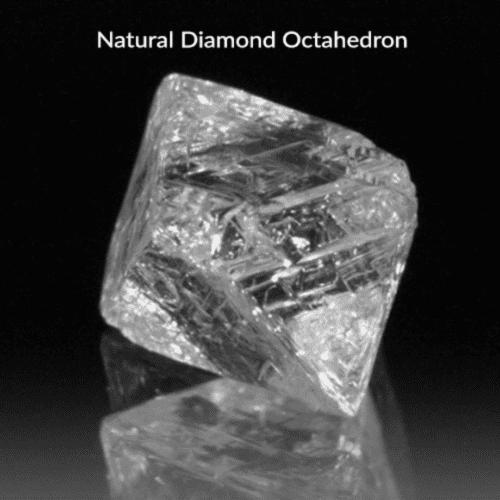How Are Diamonds Made? Natural vs Lab-Created Explained
Two Paths, One Diamond Not all diamonds come from the same place — but they all start the same way. Pure carbon, crystalized under immense pressure and heat. Whether it…
Want to learn more about the process and value of rough diamonds? Explore PriceScope’s educational resources to understand the intricacies of diamond grading, the 4Cs, and more. Empower yourself with the knowledge to make informed decisions.
A rough diamond refers to an uncut and unpolished diamond crystal, typically found in various shapes such as octahedral, cubic, or triangular (macles). Formed under extreme heat and pressure deep within the Earth’s crust, carbon atoms bond in a specific structure to create these precious stones. To the untrained eye, rough diamonds might appear as dull, glass-like fragments. Despite their initial unremarkable appearance, rough diamonds hold immense potential and value, which expert cutters unlock through a meticulous process.

Image Source: Whiteflash
Rough diamonds are sourced from the Earth primarily through two methods: Pipe Mining and Alluvial Mining.
Have questions about rough diamonds or need expert advice? Join the PriceScope online community where you can connect with diamond enthusiasts and industry experts. Share your experiences, get recommendations, and be inspired by thousands of user-shared images.
The journey from rough diamond to polished gem involves several crucial steps:
Expert diamond cutters use imaging technology to analyze the rough diamond. They determine the best way to cut the stone to maximize its size, appeal, and saleability. Inclusions or imperfections are carefully noted and managed during this stage.
Traditionally, diamonds were cut and polished by rubbing them against each other. Today, advanced technology allows for precise cuts using lasers, ensuring maximum brilliance and fire. Most rough diamonds are cut into round shapes to enhance their brilliance and preserve carat weight.
After cutting, the diamond is polished to add facets—flat surfaces that act as tiny mirrors to reflect light. A round brilliant diamond typically has 58 facets to maximize its sparkle. Advanced polishing machinery allows for precise control, producing diamonds with exceptional light performance.
Each facet is meticulously examined during and after polishing. Once polished, the diamond is graded by an in-house gemologist, predicting the grade it will receive from external grading labs.
Once polished, diamonds are sent to grading laboratories like the Gemological Institute of America (GIA) or the American Gem Society Laboratories (AGSL). These institutions assess the diamond’s color, clarity, carat, and cut. Each certified diamond receives a unique report number, which helps in tracking and verifying its quality.
Grading laboratories use sophisticated technologies to evaluate fundamental aspects of light performance, ensuring that diamonds meet stringent criteria for brightness, contrast, and dispersion. Ideal and super ideal cut diamonds are especially prized, with super ideal cuts undergoing even more rigorous assessments to ensure exceptional quality.
Begin your journey with PriceScope’s diamond search, featuring a comprehensive selection of natural and lab-grown diamonds. Use our advanced filters to find the perfect rough or polished diamond to match your unique preferences.
Yes, individuals can purchase loose rough diamonds. Buyers essentially have two options when acquiring these uncut and unpolished gems. They can either purchase directly from mining companies or obtain them from licensed diamond dealers in the secondary trading market. Purchasing loose rough diamonds offers the flexibility to choose the cutting and polishing process, ensuring the final product meets specific preferences. This approach is beneficial for both investment and personal enjoyment, provided the purchase is made through reputable sources to ensure quality and authenticity.
From their formation deep within the Earth’s crust to their radiant brilliance in fine jewelry, diamonds undergo a remarkable journey. Understanding the intricate process of sourcing, cutting, polishing, and grading rough diamonds allows us to appreciate the skill and craftsmanship involved in transforming these raw crystals into stunning gems. Each diamond, whether ideal or super ideal, tells a story of ancient origins, meticulous craftsmanship, and modern technology. So, the next time you admire a diamond’s radiance, remember the incredible journey it has taken and the expertise that has shaped its beauty and value.

Retail Diamond Prices Chart Updated Monthly.

Two Paths, One Diamond Not all diamonds come from the same place — but they all start the same way. Pure carbon, crystalized under immense pressure and heat. Whether it…
A Wedding Ring as Unique as Your Love Finding the right wedding ring isn’t just about diamonds or gold – it’s about finding the one that feels right. With hundreds…
So, you’re thinking about lab-grown diamonds? Smart move. They’re just as sparkly as the natural kind but usually cost less. But where do you actually go to buy them? It…

Want to stay updated on the most recent blogs, forum posts, and educational articles? Sign up for Bling News, PriceScope’s weekly newsletter.